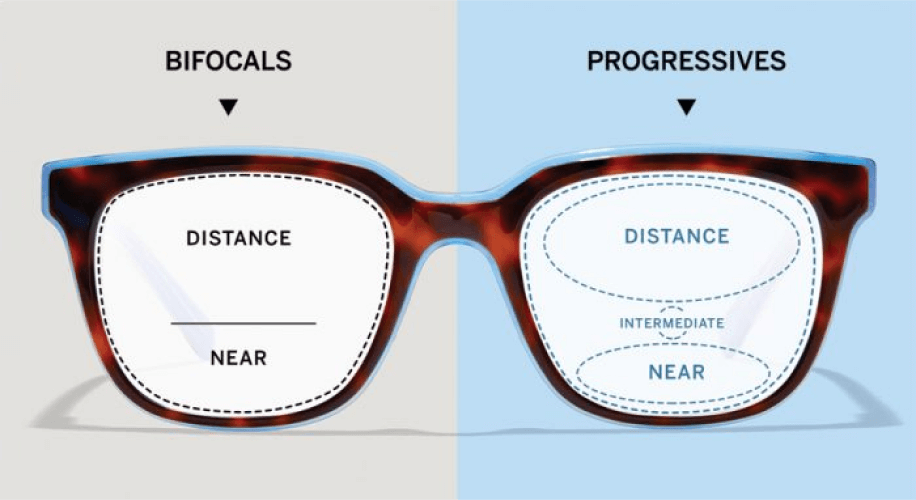Understanding Presbyopia: A Natural Part of Aging
- BY Steven Lee
- IN Eye Facts
If you’re over 40, you might have noticed that reading your phone or a newspaper requires extending your arms further. If that sounds familiar, it’s a clear sign that time spares no one, and you’ve started experiencing presbyopia.

In simple terms, presbyopia isn’t an eye disease but rather a natural degenerative change in your eye’s physiology. It affects everyone over the age of 45. You’ll notice that objects up close gradually become less clear, and to read fine print, you’ll have to hold it farther from your eyes. Unfortunately, your arms can’t extend indefinitely.
So, what can you do to correct presbyopia? Let’s take a closer look.
But first, let’s delve into presbyopia in more detail. There’s no doubt that it affects 100% of people over the age of 45. However, you might wonder why it happens in our 40s. Let’s find the answer.

Inside our eyes, behind the cornea and aqueous humor, there’s the crystalline lens. These components work together to refract incoming light and transmit it to the retina. When you’re young, the crystalline lens is flexible, acting like an adjustable optical lens, enabling you to see both near and distant objects clearly.
As you age, the crystalline lens slowly hardens and loses its elasticity. As a result, your eyesight up close is no longer as good as it was when you were young. Symptoms such as difficulty focusing on nearby objects, needing to hold your phone at arm’s length, and eye fatigue, especially during prolonged reading, become more noticeable as you get older.

Now, you might be wondering if there are any preventive measures to stop this from happening. Unfortunately, even though you can slow down the process by staying physically active, avoiding eye strain, and getting essential eye-friendly nutrients, you can’t prevent it entirely. Fortunately, while presbyopia isn’t avoidable, it’s easily correctable with the right eyeglasses.
How to Correct Presbyopia
If you, like many others, are experiencing the blurry vision of presbyopia, it’s time to consult an optometrist. Note that if you’re under 40, the issue might be farsightedness, not presbyopia. Both conditions cause blurred vision when looking up close, but your eye doctor will provide an accurate diagnosis.
Once it’s confirmed as presbyopia, it’s time to consider your eyeglass options.
Single Vision Reading Glasses
If you’ve had good distance vision most of your life, you might only need single-vision reading glasses for close-up tasks. They’re often referred to as “readers” and have positive diopters like +2.00.
But what if you don’t want to take your glasses on and off in public or if you’ve been nearsighted before? In that case, you can consider…
Bifocals
Bifocals have two different prescriptions – one for distance vision and one for near vision. This way, you can see both close-up and distant objects without taking off your glasses. However, bifocals have a visible line that some people find unattractive, and the rapid shift between prescriptions might not be suitable for computer use.

Progressive Multifocal Lenses
If aesthetics and comfort are important to you, progressive lenses are a better choice. They look like regular lenses, with no visible lines, and work like a zoom lens in a camera, allowing you to see clearly at different distances.
Of course, with great design comes greater demands. You’ll need to communicate your vision needs clearly with your eye care professional, have a precise prescription, and understand the product features to adapt better.

Zenni offers various progressive lenses to suit standard and advanced needs. Whether you need them for indoor office work, mid-range activities, or general use, there’s an option for you.
In conclusion, don’t let presbyopia-related vision problems disrupt your life. As we mentioned earlier, it’s something everyone goes through, and there are multiple correction methods available. There’s no reason to tolerate eye strain and blurred vision. Take action today to see the world more clearly!
About the Author: Dr. Steven Lee
Dr. Steven Lee is a visionary leader in the eye care and telemedicine sectors and has built a remarkable career by combining his formal training in eye care, engineering expertise, and a passion for innovation. Dr. Lee serves as Zenni’s the Head of Optical Product.
